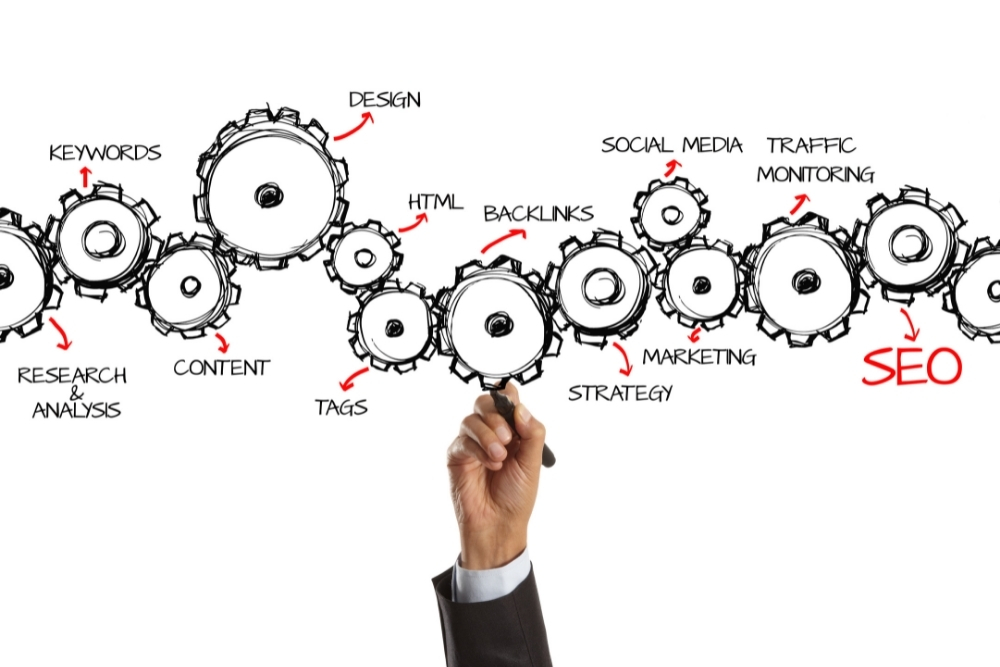Many marketing agencies primarily focus on content marketing, but search engine optimization (SEO) is another highly important factor with web design.
While reaching a target audience is of utmost importance, it’s important to reign in on content marketing efforts, especially if web design has taken a back seat.
The balance between SEO and web design is quite a delicate one. When done properly, these two can help increase traffic to a site.
With adequate web design, a company or corporation can achieve brand identity, whereas SEO combined with web design can aid a company’s marketing efforts.

Brands need SEO before anything. This is because it’s the most viable and affordable method to reach and understand new customers.
Over the last year, the need for SEO has risen to an all-time high. Consumers shifted to online buying in the masses and even traditional businesses realized they needed to shift to digital very quickly.
Most brands and businesses understand that SEO is needed for their digital properties. Most believe they know what benefits they can achieve from SEO, but many find it a fuzzy area.
There is no doubt that SEO can improve a website’s overall searchability, as well as visibility, on the web.
Today, we are going to discuss 9 reasons why SEO has become so important in the world of web design and why you need it to take your business, or site, to the next level.
SEO Builds Credibility And Trust
The main goal of any experienced SEO is to establish a solid foundation for a clean, easy-to-understand website.
It should offer an effective user experience that is easy to discover in searches. This usually comes down to the credibility and trust of the brand, as well as its digital properties.
Many factors go into establishing authority on search engines such as Google. However, such authority is usually achieved over time due to certain aspects. Such aspects are: a positive user experience, natural, easy-to-find links, positive user behavior, optimized on-page content and machine-learning signals.
Establishing this authority will usually do more for a brand than most other digital optimizations. The only issue is that it’s not possible to build this trust and credibility overnight.
It must take time, patience, effort and commitment. Much of your site’s success relies on offering users a quality product and a service that allows customers to trust the brand.
A Responsive Design – Go Mobile
More than 60% of users now search for products on mobile devices. One glaring issue, however, is that many web designs are not user-friendly on smartphones or tablets.
Therefore, visitors tend to click away within a few seconds of entering the website, due to its texts or images being too small or too big.
Poor user experiences such as this can result in a large decrease in sales for the company. However, if you tie this design into the many benefits of SEO, you can create a much better user experience.
Users may also find a business’ page easier to find, due to its higher ranking. Open rates will then become more successful.
No Spam
Incorporating SEO when you’re developing a web design can be quite the balancing act.
If the design and SEO are just a little incorrect, the site can contain too many keywords and be seen as “spam” by visitors. Too many keywords could result in the site not ranking at all.
Effective and proper SEO is a mixture of rich content, keywords, and title tags. Nevertheless, all of these elements should be original as well as relevant.
They should also be present alongside other appealing visual items, simultaneously. These include videos and images.
Compliant search engines tend to be easy to scroll through and find by search engines. All in all, it’s the web designer’s objective to produce pages that are appealing to users as well as the search engine itself.

Enhances The User’s Experience
You should never forget about the users when developing a web design with SEO in mind. A user’s experience as they move from one page to the next is just as critical as the search engine that is finding them.
You must not forget that it’s the users that are making the purchases once your page receives its ranking, not a search engine.
If your web design is not brand new and is undergoing a redesign or requires new pages, you should re-examine your existing pages. See what these page’s SEO looks like and consider whether they require a redesign for ad structure, continuity and loading.
You must address the user’s experience on every single page of the business website if you want to achieve proper search engine optimization.
Index Your Web Page
One of the most common mistakes companies make when not using a web design team is that they believe they can launch their website and search engines will pick it up automatically.
The truth is that it is not this simple. Search engines need to be told that the site exists through indexing. If this doesn’t occur, search engines will take a lot longer to rank them, if even at all.
There are ways to achieve this, such as with XML sitemap, but site mapping is not the best way to get noticed by search engines.
The best method is, you guessed it, to use SEO and index the site. Then, you should update it regularly.
By doing this, search engines can see pages that were indexed previously, but are now in need of review. This method results in better optimization and better chances of getting more visitors to the web page.
Developing A Content Strategy
Once your web design is well underway, it’s time to consider the site’s content strategy. This ties in with what we discussed earlier in regards to content marketing. But, at this point of your plan, it’s more focused on what the consumer needs after they have loaded your web pages.
Even if the user experience has been resolved, you need to consider what these users will be looking for when visiting your site. Think about what problems they are trying to find answers to and whether they are searching for any particular product, video, article, or service.
When you brainstorm these ideas (and many more), you can develop a content strategy. Once you have considered everything you can think of, it will become much easier to integrate all of your plans with search engine optimization.
While it can be time-consuming, these efforts play a vital role in your site’s ongoing position regarding search engines. They will also have a great impact on the site’s success, or failure, regarding SEO ranking.
For instance, if a web developer has a solid understanding of their business strategies, they can find it easier to develop a set of keywords users will be more likely to search. These will then relate to the site, resulting in greater traffic flow of visitors.
Link building further compounds these efforts. Link building helps businesses improve their SEO and, when combined with a firm content strategy, web pages have a much higher chance of being found by users and potential customers. The key to all of this is to use credible sites that boast quality as well as relevant content.
SEO Helps Businesses Understand The Voice Of Their Customers
SEO simply tells us what customers want and what they need. This can be from macro market shifts to understanding the consumer’s intent in minuscule detail.
SEO formats and data, whether it is spoken or word, helps give us a clear signal of the behavior and intent of the users that visit our sites. This is done in various ways, such as SERP analysis, search query data, AI insights and analytics data.
Once you understand your customer’s voice, you can target your web design to them. This will lead to an increase in traffic and improved visibility on different search engines such as Google or Microsoft Bing.

Impacts The Buying Circle
Research continues to be a critical element of SEO with the importance of real-time research growing all the time.
By using SEO tactics to send messages about new deals, products and services, as well as the importance of what you offer to your customers, can be a total game-changer. Overall, it will have a significant positive impact on the buying cycle of your web pages.
Brands have to be visible where people need them if you want to have an effective and worthwhile connection. Local SEO can enhance a website’s visibility and allow potential customers to find everything they need, easier.
SEO Is Constantly Improving
While SEO tactics can have a huge positive impact on websites and different digital properties, if it is not re-evaluated consistently over some amount of time, it will undoubtedly reach a threshold where it can not improve any further.
The search world evolves due to constant monitoring for changes. This is so web pages stay ahead of their competitors and remain on or around page 1.
By being proactive and monitoring for certain algorithm changes, brands can reap the rewards and benefits.
Google makes thousands and thousands of algorithm changes each year. If you start to fall behind, it will be extremely difficult to crawl your way back to the first page of the search engine.
In Summary
Whether it’s searching for various projects, finding solutions to issues, or wanting information on something in particular, users go online for many different reasons.
However, if a business does not have much presence online, it will get lost under thousands of other sites. SEO ensures a site becomes more visible and, most vitally, increases traffic to different web pages.

Recent Comments